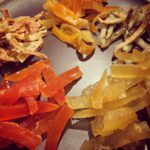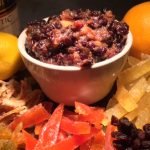Sponge Toffee
Ingredients
- 1 cup white sugar
- 1 cup dark corn syrup
- 1 tbsp white vinegar
- 1 tbsp baking soda
Instructions
- Heat sugar, corn syrup and vinegar until it reaches 300F on a candy thermometer and then remove from heat.
- Sprinkle in baking soda, stirring as you add (to avoid clumps).
- Pour onto a buttered baking tray and let cool.
- When completely cold, break into pieces and store in an airtight container.
- OPTION: Drizzle melted chocolate over your pieces of sponge toffee and let cool.
- Enjoy!
Notes
Recipe: Molasses Taffy
Molasses Taffy
Ingredients
- 1 cup molasses
- 1 cup white sugar
- 1 cup brown sugar
- 1/2 cup corn syrup
- 1 tbsp butter
- 1 tbsp white vinegar
- 1/2 cup water
- 1 tsp baking soda
Instructions
- Before you start, gather some supplies you’ll need later: butter a baking sheet, cut out wax paper squares and butter the blades of a pair of kitchen scissors.
- Heat all ingredients except butter and baking soda until it reaches 255F on a candy thermometer and then remove from heat.
- Stir in butter and sprinkle in baking soda, stirring as you add (to avoid clumps).
- Pour onto a buttered baking tray and let cool until you can pick it up. (It’s easier to work the hotter it is, so don’t wait too long.)
- Cover your hands in butter and then pull taffy by twisting and stretching it, and then folding in half. Repeat this motion until the taffy becomes lighter in colour. (If hot enough, the taffy will want to sag and stretch on it’s own.)
- When ready, form into a rope 3/4″ wide and cut into chunks with kitchen scissors. (Make sure you butter the blades beforehand!)
- Wrap in squares of wax paper and twist both ends to close. Store in an airtight container.
- Enjoy!
Notes
Recipe: Peachy Grist Mill Streusel
Peachy Grist Mill Streusel
Ingredients
- 4 ripe peaches
- 3/4 cup butter soft
- 1 1/2 cups sugar
- 3 eggs
- 2 tsp vanilla
- cups grist mill flour
- 1 1/2 tsp baking powder
- 1 1/2 tsp baking soda
- 2 tsp ginger
- 1 tsp cinnimon
- 3/4 tsp salt 1 1/2 cups sour cream
Streusel
- 1/3 cup brown sugar
- 1/4 cup grist mill flour
- 1/4 cup chopped almonds
- 2 Tbsp chopped cyrstal ginger
- 2 Tbsp cold butter diced
Instructions
- Peel peaches; cut and slice thinly and set aside. In large bowl, beat butter and sugar until fluffy. beat in eggs, one at a time. beat in vanilla. In a seperate bowl, whisk flour, baking powder, baking soda, spices and salt. Stir into butter mixture alternately with sour cream, making 3 adds of ingredients. Spread batter evenly in greased 13×9 inch cake pan; arrange sliced peaches over top.
Streusel
- In a bowl, mix sugar, flour, almonds and ginger with pastry blender and cut in butter. This is now a crumble mixture. Sprinkle evenly over fruit.
- Bake in centre of 350°F oven for about 1 hour. Let cool in pan.
Notes
Recipe: Rhubarb Meringue Pie
Rhubarb Meringue Pie
Ingredients
- 4 cups rhubarb finley chopped
- 3 egg yolks
- 1 cup sugar
- 2 Tbsp grist mill flour
- 2 Tbsp melted butter
- 3 egg whites
- 1/3 cup sugar
- Pastry for 9 inch single crust pie
Instructions
- Combine rhubarb and egg yolks. Add 1 cup sugar and flour and mix well.
- Stir in butter and spoon into pie shell. Bake at 350°F for 30 minutes or until set. Beat egg whites until soft peakes. Continue to beat and slowly add 1/3 cup sugar until thick and glossy. Heap lightly over pie and spread to edges of the crust. Turn over to 400°F and bake pie for about 10 minutes until golden brown.
Notes
Recipe: Victorian Christmas Cake
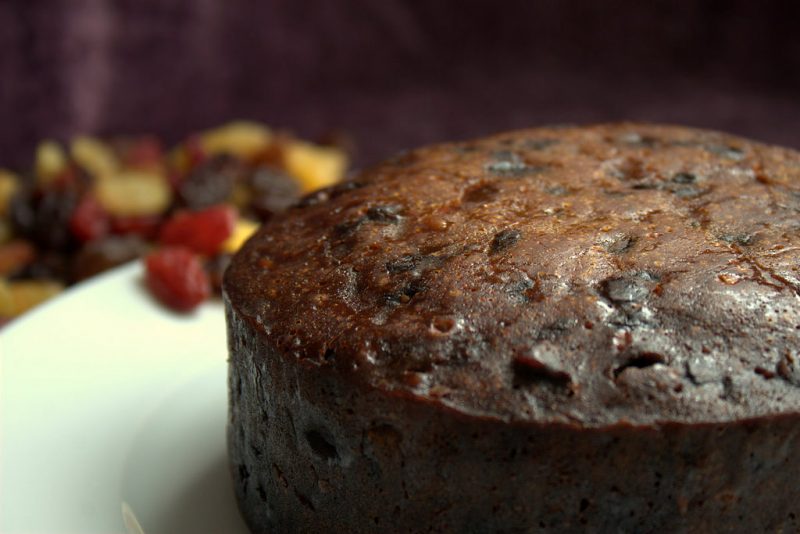
Victorian Christmas Cake
Ingredients
- 525 g 3 ½ cups currants
- 225 g 1 ½ cups golden raisins/sultanas
- 225 g 1 ½ cups raisins
- 110 g 3/4 cup mixed candied peel, finely chopped (make your own, using this easy recipe)
- 165 1 cup glace cherries, halved
- 300 g 3 1/3 cups plain flour
- Pinch salt
- 1/4 level teaspoon ground cloves
- 1/4 level teaspoon ground allspice
- ½ level teaspoon ground cinnamon
- ½ level teaspoon freshly ground nutmeg
- 300 g 10 oz butter, slightly softened
- 300 g 1 1/3 cups soft brown sugar
- Zest of ½ lemon
- 6 large eggs lightly beaten
- 3 tablespoon brandy plus extra for feeding
Instructions
- Heat the oven to 150C/300F/Gas 2
- The temperature is low as the cake needs a long slow bake. It is packed with sugars, fruits and brandy and if the temperature is any higher the outside of the cake will burn and the inside be undercooked.
- Line a 23cm (9″) cake tin with 2 thicknesses of parchment. Tie a double band of brown or newspaper paper around the outside. This acts as an insulator and to prevent the cake from burning.
- In a large roomy baking bowl mix the currants, sultanas, raisins, peel and cherries with the flour, salt and spices.
- In another large bowl cream the butter with the sugar until light and fluffy. Stir in the lemon zest. Add the beaten egg to the butter mixture a little bit at a time, beating well after each addition – do not try to rush this process as the mixture could curdle. If it does curdle simply add a tbsp of flour and mix again, this should bring the mixture back together. If it doesn’t come back together, don’t fret, the cake will still be delicious.
- Carefully fold in half the flour and fruit into the egg and butter mixture, once incorporated repeat with the remaining flour and fruit. Finally add the brandy.
- Spoon the cake mixture into the prepared cake tin making sure there are no air pockets. Once filled smooth the surface with the back of s spoon and make a slight dip in the center (this will rise back up again during cooking and create a smooth surface for icing the cake).
- Finally, using a piece of paper towel clean up any smears of cake batter on the parchment wrapping, if left on they will burn, and though it won’t affect the cake, it doesn’t smell too good.
- Stand the tin on a double layer of newspaper in the lower part of the oven and bake for 4½ hours. If the cake is browning too rapidly, cover the tin with a double layer of parchment paper after 2½ hours. During the cooking time avoid opening the oven door too often as this may cause the cake to collapse.
 After 4½ hours check the cake is cooked. The cake should be nicely risen and a deep brown all over. Insert a skewer or fine knife into the centre of the cake. If there is sticky dough on the skewer when you pull it out it needs cooking longer, if it is clean, the cake’s done and remove from the oven.
After 4½ hours check the cake is cooked. The cake should be nicely risen and a deep brown all over. Insert a skewer or fine knife into the centre of the cake. If there is sticky dough on the skewer when you pull it out it needs cooking longer, if it is clean, the cake’s done and remove from the oven.- Leave the cake to cool in the tin on a wire rack for an hour, then remove from the tin and leave to cool completely. Once cooled prick the surface of the cake with a fine metal skewer and slowly pour over 2 – 3 tbsp brandy. This feeding should be repeated every two weeks up until Christmas. The cake should be stored wrapped in parchment paper in an airtight tin.
Notes
Recipe: Candied Peel

After a lifetime of the dull-flavoured chopped “peel” you find in the grocery store at Christmas time, this easy recipe is a true revelation. You can use any kind of citrus, and each variety will give you a different taste and texture experience.
We love eating candied peel on it’s own, or on a place with nuts and cheese, but it also makes an out-of-the-world incredibly in your homemade fruitcake, mincemeat or shaved thinly on your whipped shortbread.
Candied Peel
Ingredients
- Your favourite citrus fruit oranges, lemons, grapefruit, limes, etc
- 1½ cups granulated sugar
- ¾ cup water
Instructions
- Rinse the fruit.
- Remove the skin (peel and pith, the white part), and cut the skin into strips about ¼” wide. Set the fruit itself aside and plan something fantastic to make with it.
- Place the strips of peel in a large saucepan and cover with cold water.
- Set on the stove on high heat and bring to a boil. Drain the water from the peels and repeat this process twice more.
- In a small bowl, whisk together the sugar and ¾ cup water.
- Pour the sugar water into a medium saucepan and bring to a simmer. Let the mixture cook for 8-9 minutes at a constant simmer.
- Add the peel and cook for 45 minutes to 1 hour, adjusting heat as necessary to maintain the simmer. Avoid stirring, as this will cause crystallation. If necessary, swirl the pan to make sure that all of the peels get covered with the syrup. At the end of this period, the peels should be translucent.
- Drain any remaining syrup from the peels and set aside for other use (perhaps tea?!) There will probably be only a tablespoon or two of syrup left. Spread the peels out on a drying rack and leave to dry for 4-5 hours. Store in an airtight container with some granulated sugar at the bottom.
Notes
Recipe: Victorian Mincemeat Tarts
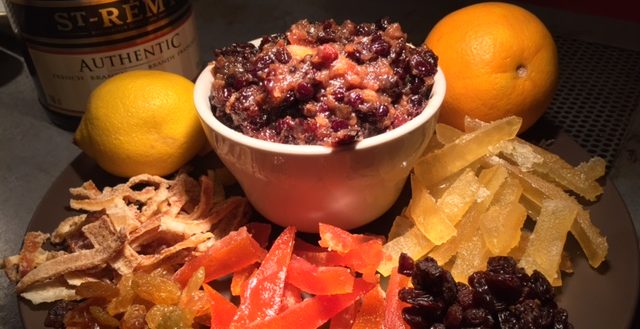
The sweet and spiced fruity filling we now think of as mincemeat is a pale imitation of the minced meat (and spice, preserved with brandy) of long ago that was served as a main course, instead of a dessert. As spices and fruit became more commonly available historically, the recipe shifted from savory to sweet. This recipe bridges the gap, providing a filling that’s familiar (if richer and tastier) while still including not only the beef fat (suet) but also some meat itself.
This is a great recipe to make ahead; the alcohol and sugar in the recipe provide a strong preservative effect and properly canned, this filling can be stored for a year or longer and getting tastier as it does so.
Check out this article for some great stories form the history of mincemeat. We’re particularly curious about the whale mincemeat in 1861…
Victorian Mincemeat Tarts
Ingredients
For the mincemeat
- 450g / 1lb sirloin steak finely chopped
- 450g / 1lb suet grated (if you buy a bag of “chopped suet”, you’ll likely find flour listed as an ingredient; try instead of find pure suet at a local butcher. If included, the flour makes the texture of the filling much more pasty.)
- 4 large apples peeled, core removed, flesh chopped
- 1.35kg / 3lb currants
- ½ small loaf day-old bread grated
- Freshly grated nutmeg to taste
- Ground cinnamon to taste
- Ground cloves to taste
- Ground ginger to taste
- Salt and freshly ground black pepper
- 450g / 1lb sugar
- 2 lemons zest and juice
- 3 large oranges juice only
- Candied peel diced (optional,o but its easy to make your own and adds a ton of flavour)
- 250ml / 9fl oz brandy
- 250ml / 9fl oz ruby port
For the shortcrust pastry
- 225g / 8oz flour plus extra for dusting
- 115g / 4oz butter or margarine cut into cubes
- Water as necessary
- 4-6 tsp milk
- 1 tsp sugar
Instructions
- Preheat the oven to 200C/400F.
- For the mincemeat, mix all of the mincemeat ingredients together in a large bowl, using your hands, until well combined.
- Transfer the mixture to a saucepan and heat over a very low heat for 3-5 hours, stirring occasionally, or until it has reduced to a thick, dark paste.
- Meanwhile, for the shortcrust pastry, sift the flour into a large mixing bowl. Add the butter or margarine cubes, then rub them into the flour using your fingertips until the mixture resembles fine breadcrumbs.
- Gradually add the water, a tablespoon at a time, stirring well until the mixture comes together as a stiff dough.
- Turn out the pastry onto a lightly floured work surface and knead well until smooth and elastic.
- Roll out the pastry onto a lightly floured work surface to a 1cm/0.5in thickness. Using an upturned bowl, cut 8-10 discs from the pastry. Reserve the remaining pastry.
- Place a coffee mug into the centre of each pastry disc and draw the sides of the pastry up against the mug, overlapping the edges, to form free-standing pastry cases.
- Divide the mincemeat evenly among the pastry cases.
- Roll out the remaining pastry onto a lightly floured work surface. Using the same mug as before, cut 8-10 discs from the pastry to create ‘lids’.
- Place one pastry ‘lid’ on top of each pie, tucking the edges into the pastry case. Pinch the pastry together well to prevent the filling from leaking out during baking. Using a sharp knife, cut a cross into the top of each pastry lid to allow the steam to escape.
- In a bowl, mix together the milk and sugar until the sugar has dissolved. Brush the top of each pie with this mixture.
- Place the mince pies onto a baking tray. Bake in the oven for 20 minutes, or until the pastry is crisp and golden-brown.
- Remove the mince pies from the oven and cool on a wire rack.
Notes
Recipe: Tomato Tart


As we mentioned in our previous recipe for tomato jam, we’ve been part of a project to grow out tomatoes for the Canadian Seed Library, a project of Seeds of Diversity, an exceptional non-profit dedicated to collecting, preserving and sharing heritage seeds. Through the first week of October, we’ll be exploring recipes that suit each of these varieties.
Our second tomato from the Library is a large cherry tomato called Camp Joy. (You can see them in the image above.) It’s about 4cm, perfectly round, dense, low in seeds, and very flavourful. Camp Joy is named after Camp Joy Gardens near Santa Cruz, California that was one of the early leaders in bio-intensive gardening. It was developed by noted English gardener Alan Chadwick, who was at Camp Joy teaching classes in organic gardening.
An oven-baked tart is a great way to showcase this gem of a tomato and we love any excuse to play with puff pastry.
Tomato Tart
Ingredients
- a handful of large ripe cherry tomatoes, washed and cut in half (Camp Joy tomatoes, being the size of a two-bite brownie, are perfect for this)
- one package puff pastry
- 3 tbsp soft goat cheese
- a few tbsp fresh herbs we love basil, but you can try thyme, rosemary, chives or parsley
- olive oil
- salt and pepper to taste
- Although we have a couple of technique suggestions this simple recipe is just an excuse to play and experiment. Mix tomato varieties, try different cheeses and consider including other ingredients like roasted garlic or caramelized onions.
Instructions
- Defrost the puff pastry, for an hour on the counter or overnight in the refrigerator.
- Preheat oven to 375F. Line a baking sheet with parchment paper.
- Cut the tomatoes in half, then place cut-side down on paper towel (to absorb some of the moisture) for up to a half hour.
- Unfold and roll out the pastry into an 11 inch square on a lightly floured surface. Trim off the corners with a sharp knife to shape the pastry sheet into a circle; score a circle (lightly track it with a knife) around 1 inch in from the edge.
- Crumble the goat cheese into the centre of the crust, then put the tomatoes on, cut side up. Brush tomatoes with olive oil, then season with salt and pepper and sprinkle with fresh herbs.
- Bake in middle rack of oven for 15 minutes or until pastry is golden brown.
- Cut into quarters, serve cool or hot and enjoy!
Notes
Recipe: Tomato Jam


This summer, we had the opportunity to grow a half dozen varieties of tomato for the Canadian Seed Library, a project of Seeds of Diversity, an exceptional non-profit dedicated to collecting, preserving and sharing heritage seeds.
As one of about sixty growers from across Canada for this project, we’re obliged to plant the seeds they send us, tend them well, document our results and then send back some seed so that they can be put back into the library for the future. (All seeds have a limited shelf-life, so need to be grown out every so often to get fresh seed and reset the clock.)
In the interest of ensuring a healthy amount of genetic diversity, we need to grow many more plants of each variety than would be needed just for seed, so we now find ourselves with an abundance of unique tomatoes. We’ll be exploring recipes that suit each of these varieties over the next couple of weeks.
Our first tomato from the Library is a top-notch paste tomato called Federle. (You can see it front-and-center in the image above.) It’s big, dense, low in seeds, and very flavourful. R. W. Richardson of New York introduced this variety to Seed Savers Exchange (an American organization similar to our own Seeds of Diversity) in 1991. He had obtained the tomato through a seed swap with a gardener from West Virginia–its previous history is unknown.
Tomato jam is the perfect use for a tomato like this; the long simmer concentrates the bold flavour. Once finished, this jam is perfect smeared on a cracker with soft goat cheese. It’s also a great addition on a plate of cured meats and cheeses or as an out-of-this-world condiment for a grilled cheese sandwich.
Try this recipe with any ripe paste tomatoes you can find and you won’t be disappointed!
Tomato Jam
Ingredients
- 1 ½ pounds good ripe paste tomatoes our Federle’s were perfect for this, cored and coarsely chopped
- 1 cup sugar
- 2 tablespoons freshly squeezed lime juice
- 1 tablespoon fresh grated or minced ginger
- 1 teaspoon ground cumin
- ¼ teaspoon ground cinnamon
- ⅛ teaspoon ground cloves
- 1 teaspoon salt
- if you like spice fresh or dried peppers (jalapeno, chili flakes, etc) can be added to taste
- Although we prefer this version where the sugar adds a sticky sweetness that makes it feel like jam, some commenters on the original recipe suggest reducing the amount of sugar. Trust your taste buds.
Instructions
- Combine all ingredients in a heavy pot then bring to a boil over medium heat, stirring frequently.
- Reduce heat and let simmer, stirring once in awhile until mixture has consistency of thick jam after 90 minutes, or more. Take care to ensure it doesn’t burn to the bottom of the pot, which becomes more likely the longer it cooks.
- When ready, pour into jars and put in your fridge. You can also put this jam into sterilized jars and process them in a boiling water bath. With intact seals, unopened jars of tomato jam will last up to two years. Kept in the fridge, it will keep for at least 6 months.

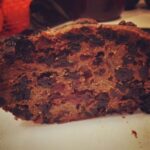
 After 4½ hours check the cake is cooked. The cake should be nicely risen and a deep brown all over. Insert a skewer or fine knife into the centre of the cake. If there is sticky dough on the skewer when you pull it out it needs cooking longer, if it is clean, the cake’s done and remove from the oven.
After 4½ hours check the cake is cooked. The cake should be nicely risen and a deep brown all over. Insert a skewer or fine knife into the centre of the cake. If there is sticky dough on the skewer when you pull it out it needs cooking longer, if it is clean, the cake’s done and remove from the oven.